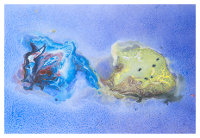Speaker
Daniel Zablocki
(Uniwersytet Wrocławski)
Description
An important first step in the program of hadronization of chiral quark models is the bosonization in meson
and diquark channels. This procedure is presented at finite temperatures and chemical potentials for the
SU(2) flavor case of the NJL model with special emphasis on the mixing between scalar meson and scalar
diquark modes which occurs in the 2SC color superconducting phase. The thermodynamic potential is
obtained in the gaussian approximation for the meson and diquark fields and it is given the Beth-Uhlenbeck
form. This allows a detailed discussion of bound state dissociation in hot, dense matter (Mott effect) in
terms of the in-medium scattering phase shift of two-particle correlations. It is shown for the case without
meson-diquark mixing that the phase shift can be separated into a continuum and a resonance part. In the
latter, the Mott transition manifests itself by a change of the phase shift at threshold by π in accordance
with Levinson’s theorem, when a bound state transforms to a resonance in the scattering continuum. The
consequences for the contribution of pionic correlations to the pressure are discussed by evaluating the Beth-
Uhlenbeck equation of state in different approximations. A similar discussion is performed for the scalar
diquark channel in the normal phase. Further developments and applications of the developed approach are
outlined.
Author
Daniel Zablocki
(Uniwersytet Wrocławski)
Co-authors
Aleksandr Dubinin
(University of Wroclaw)
David Blaschke
(University of Wroclaw)
Michael Buballa
(T)
gerd Roepke
(U)
